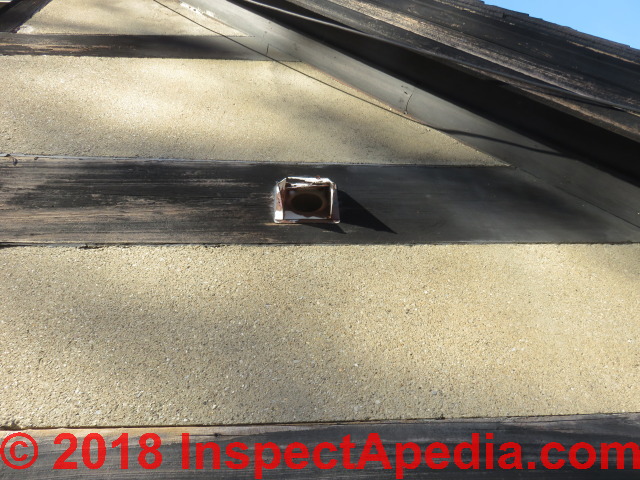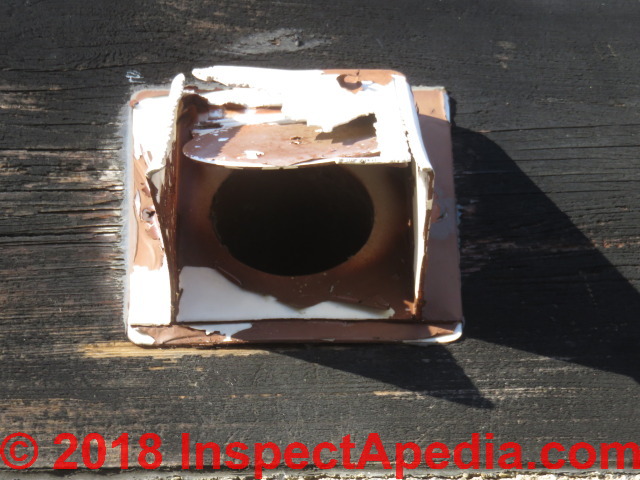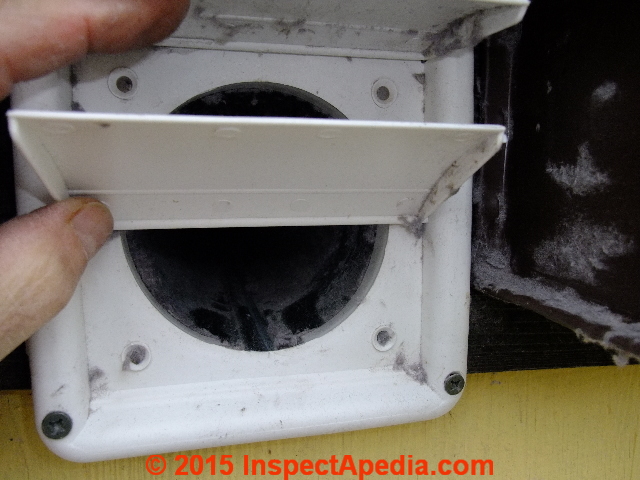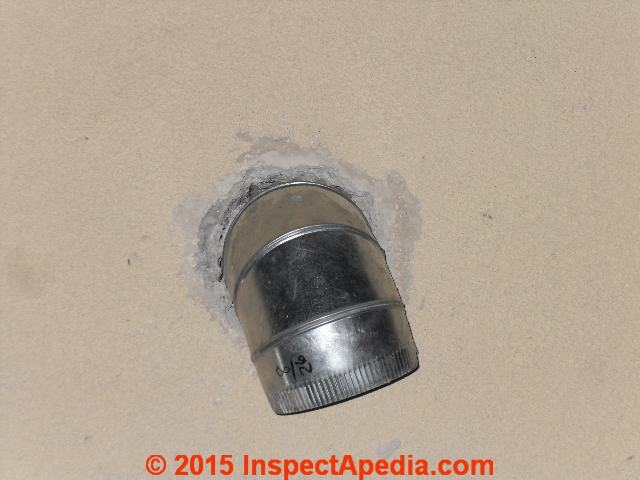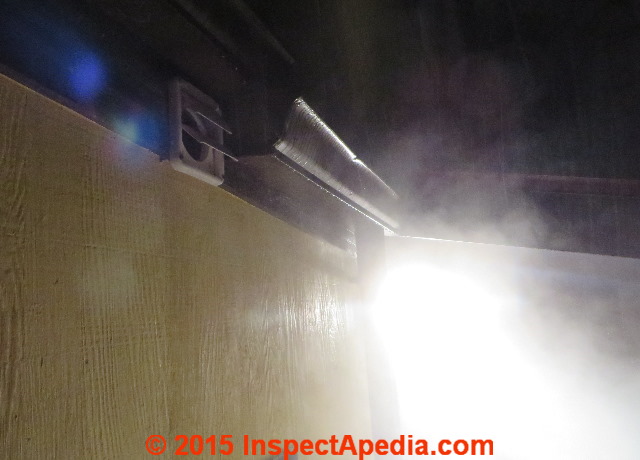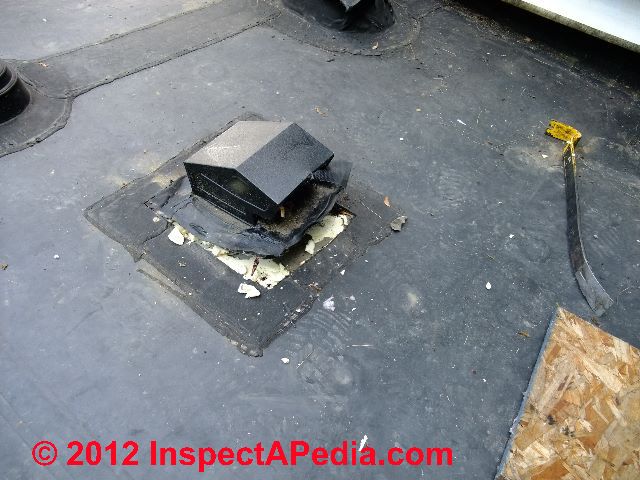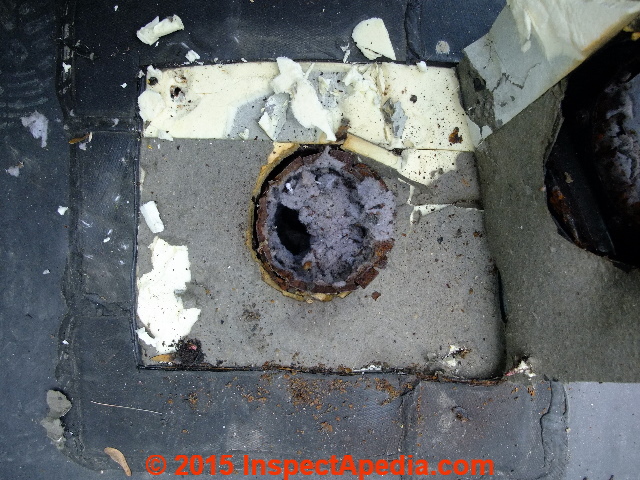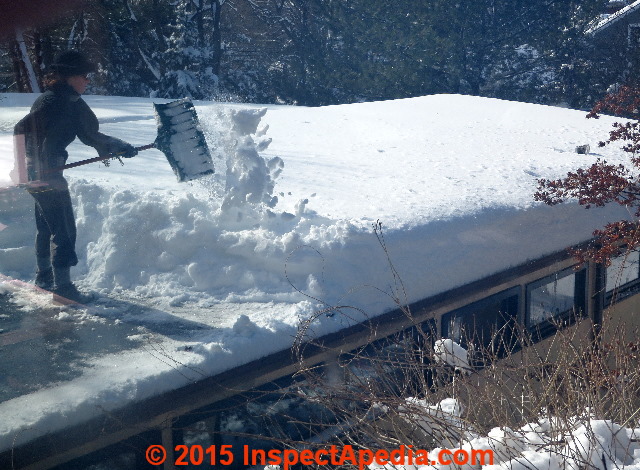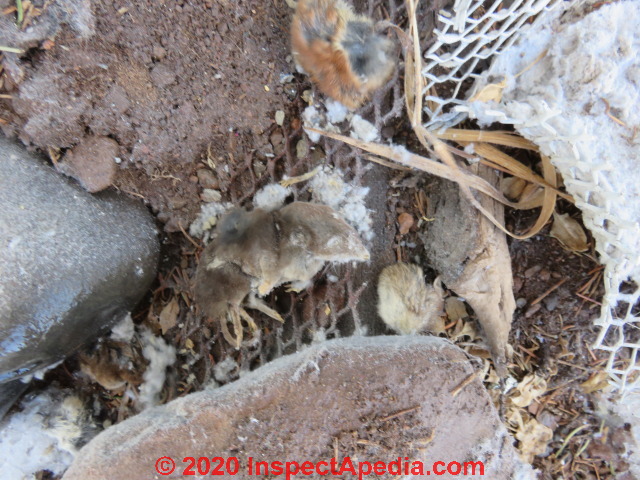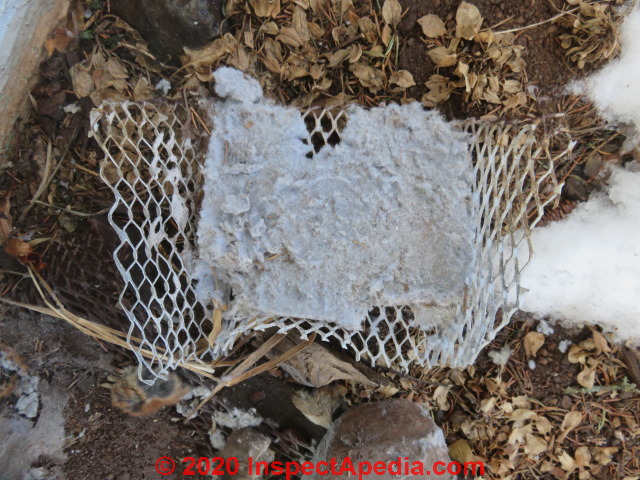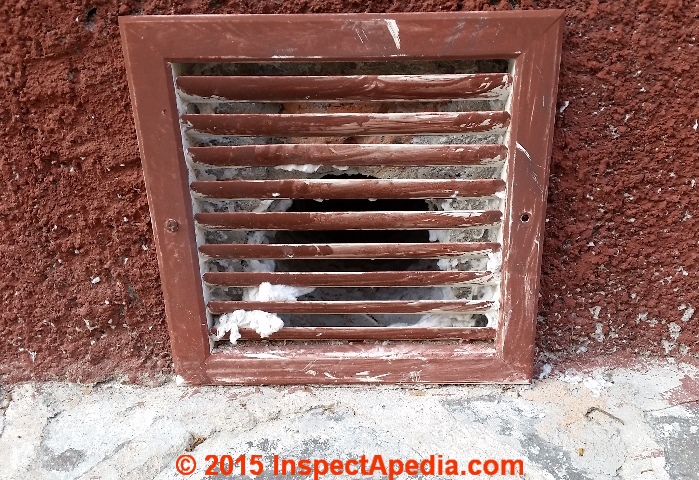 Clothes Dryer & Bath Exhaust Vent Termination / Screens
Clothes Dryer & Bath Exhaust Vent Termination / Screens
Dryer vent terminations at walls or rooftops
- POST a QUESTION or COMMENT about clothes dryer exhaust venting, ducting installation procedures, codes, standards
Clothes dryer exhaust vent termination at walls or rooftops:
Clothes dryer vents should terminate outdoors and should be screened enough to prevent entry by animals as well as to minimize cold back-drafting when the dryer is not in operation.
This article describes problems with lint-clogging at the dryer vent screen and suggests regular inspection & cleaning and perhaps installation of clog-resistant dryer vent terminating devices that reduce lint clogging. (They do not completely prevent lint clogging.)
At the top of this page: a sidewalk-level commercial dryer vent in San Miguel de Allende, Guanajuato. This dryer vent is not so easy to clean and is clog-prone.
InspectAPedia tolerates no conflicts of interest. We have no relationship with advertisers, products, or services discussed at this website.
- Daniel Friedman, Publisher/Editor/Author - See WHO ARE WE?
Clothes Dryer Exterior Wall Termination, Covers, Shields & Rooftop Dryer Vent Warnings
Standard or typical clothes dryer wall vents like the angled vent hood shown above have a hinged flapper door that is opened by the pressure of the dryer exhaust air.
Watch out: do not use a wall vent hood that uses a magnetic catch to hold the flapper door from opening.
Magnetic-latched vent hoods may be sold to resist wind uplift and drafts but in a clothes dryer application they're dangerous as the flapper may not open when it should, risking a clothes dryer fire.
Our sketch below shows three types of dryer exhaust vent hoods: from left to right,
- angled hood - a single round hinged flapper door opened by dryer air pressure
- box, hood - operating the same as the angled hood
- louvered hood - with multiple hinged horizontal louvers that are intended to open in response to dryer air pressure
All three of these dryer exhaust vent hoods or wall termination covers appear in a Whirlpool dryer manual as recommended exhaust hood styles.
Animal Entry Risks at Bathroom Vents & Clothes Dryer Vents
Photo: a rusted, inoperative bath or dryer vent termination in the gable end wall of a Poughkeepsie NY home.
This vent has lost its closing cover, is badly rusted, and in windy rainy conditions the vent may also be leaking into the home's exterior wall.
Watch out: In addition to the unpleasant dose of cold air that may be blowing onto people stepping out of a shower (if this is a bath vent), the opening is an invitation to birds or squirrels to nest in the vent, blocking it.
The results of a blocked bath vent are indoor moisture problems and potentially biological hazards, depending on just who built their nest inside the vent or vent duct.
The results of a blocked clothes dryer vent can be more immediately dangerous, risking clothes dryer overheating and a building fire.
Below:
Here is a closer look at this antique, dysfunctional and leaky exhaust vent termination cover.
Louvered-dryer vent clog risks
Below are three types of dryer vent termination hoods.
OPINION: Watch out: we have found serious and chronic lint clogging of louvered dryer exhaust vent hoods IF the hood uses multiple louvers that are small in width. At page top I show an "always open" louvered dryer exhaust vent screen blowing lint onto a sidewalk in San Miguel de Allende.
This is a commercial laundromat facing heavy dryer usage. I have, on occasion seen this opening totally blocked by lint.
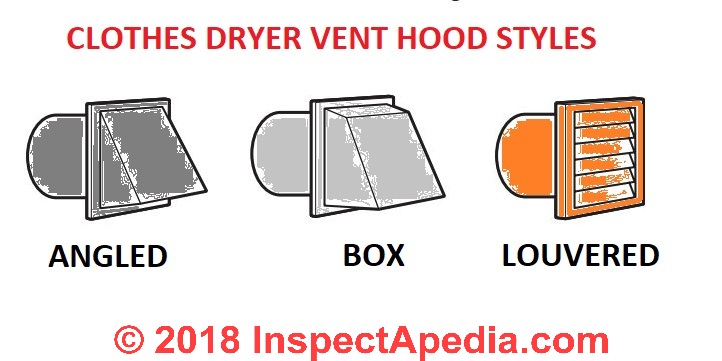 Shown at the right side of the sketch (colored orange for identification) is a louvered dryer vent hood sporting six hinged horizontal louvers - a design I think is clog prone.
Shown at the right side of the sketch (colored orange for identification) is a louvered dryer vent hood sporting six hinged horizontal louvers - a design I think is clog prone.
On the other hand, a louvered vent hood with just two or perhaps three flapper vanes (as I will illustrate below) is in my experience less prone to lint clogging, probably because when the dryer is running and the louvers open the free opening space is larger.
Exterior wall clothes dryer vent termination clogging check
Check the exterior wall dryer vent screen monthly for lint blockage.
Lint blockage and clogging often occurs right at this screen, causing longer dryer operating times and possibly overheating.
Watch out: In addition to lint clogging, some dryer vent terminations and covers, particularly those that rely on a flapper that is opened by the moving exhaust air, can become stuck in the open position, inviting dangerous vent line clogging by entering birds or insects.
Such vents may continue to pass dryer exhaust but you'll notice that when the dryer is off the flapper is not closed.
That's a clue that the vent needs more-frequent inspection and cleaning.
Our clothes dryer vent photos below illustrate lint clogging at an exterior dryer wall vent after six months' of usage.
Screens over the dryer exhaust vent clog quickly and are prohibited in many jurisdictions.
These pictures show why it is so important to inspect and clear lint from the dryer wall vent at least every few months.
Because this was a brand new dryer vent installation, the rate of dryer vent system lint accumulation is unambiguous.
The laundry and clothes dryer system in this home was used by a family of four, including two young children for a period of just six months.
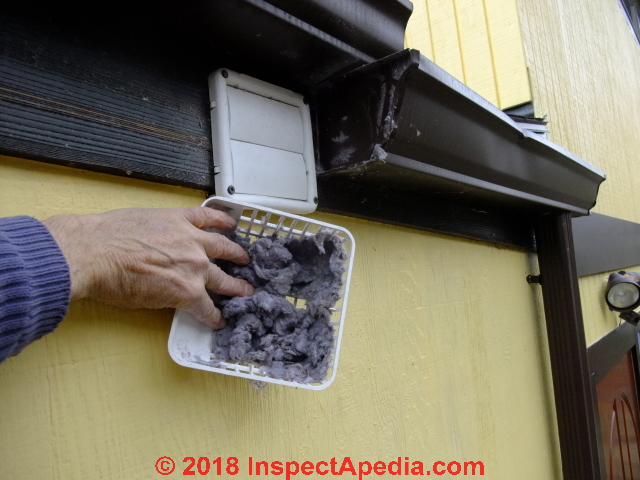
Below we illustrate our inspection of the interior of this six-month-old laundry dryer vent duct system.
We removed the outer screen on this vent as that would allow more lint to blow freely to the outdoors and would slow the system clogging rate. The screen was unsafe.
Below I'm inspecting the vent termination louvers for free movement.
Watch out: like the dryer vent termination snafu shown below (this is from a different building), do not leave off the dryer wall vent hinged, louvered-rodent cover itself: doing so invites birds or rodents to nest in the duct system, leading to unsanitary conditions, vent blockage, and fire risk.
Below I'm showing the plastic screen that was sold with this two-louvered dryer vent termination cover. (We did not re-install this screen.)
Above: I am removing the plastic screen and below I've opened the hinged louvers to show the view of the interior of the dryer exhaust duct.
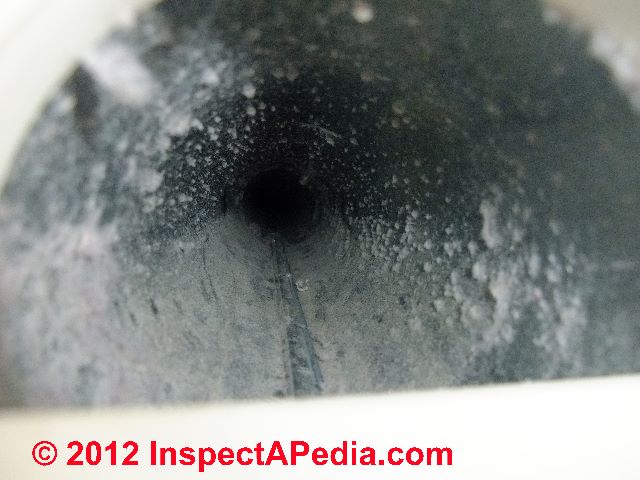
Above you can see six months of lint accumulation - rather light - in a brand new, solid metal 4" clothes dryer vent system that began with no blockage but that apparently was not checked nor cleaned during six months of use.
Below: We inspected this dryer exhaust vent terminal covering with the dryer running on a chilly night, giving a good view of the freely-opening louvers as well as a large billowing cloud of moisture condensing from the hot humid dryer exhaust air.
Rooftop Clothes Dryer Vents Also Clog & May Be Blocked by Snow or Ice
Our photos just above and below illustrate our investigation of a lint-clogged rooftop clothes dryer vent located on a low slope roof in New York. Below you see years of lint accumulation in the dryer vent duct on this home.
This 20+ year old clothes dryer vent system had become totally blocked with lint (a fire hazard as discuss below) and of course the cost to operate the clothes dryer was multiplied by the long run-time necessary because there was no functional exhaust of hot moist air.
A symptom of the trouble was that the owners noticed that the clothes dryer was really hot at the end of a dryer cycle.
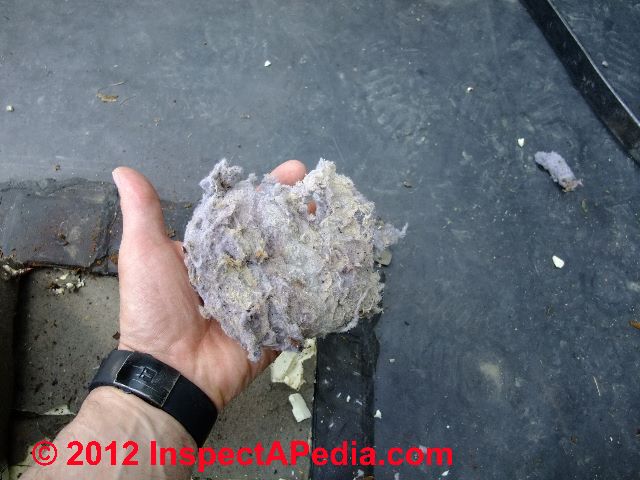
Equally poor design of this clothes dryer vent system was its installation on a nearly flat roof in a climate where winter snow cover could completely cover and block the vent even if its internal ducting were not already clogged by lint.
Below: the same roof where this clothes dryer vent is installed is shown covered in nearly a meter of snow.
No clothes dryer can melt its way through so much deep snow: the dryer vent will be initially blocked by snow, and when the dryer is operated the result may be a rooftop clothes dryer vent that is further blocked by ice from melted snow or even a dryer vent that blocks open and allows melting snow to enter the building.
This rooftop dryer vent design is more likely to cause a dryer fire than to put out the fire by melting rooftop snow.
Watch out: as you can see above, such deep snow will completely block a rooftop clothes dryer exhaust vent.
Air-Operated Exterior Clothes Dryer Wall Vents Avoid Lint Clogging
This topic has moved to its own home page
at CLOTHES DRYER LINT CLOG RESISTANT SCREENS
Fire Hazards from Clogged or Improperly-Installed Clothes Dryer Vents
This discussion moved to a separate page:
CLOTHES DRYER FIRE HAZARD WARNINGS where we include more photos of blocked dryer vents and ducts.
This article series describes good practices for clothes dryer vent installation, lint traps, wall vents, filters, and screens.
We include a list of clothes dryer fire safety hazards and other clothes dryer installation or maintenance mistakes that are either unsafe or that interfere with effective, economical dryer operation.
We discuss types of dryer vent ducting and dryer vent doors or opening protection devices
...
Reader Comments, Questions & Answers About The Article Above
Below you will find questions and answers previously posted on this page at its page bottom reader comment box.
Reader Q&A - also see RECOMMENDED ARTICLES & FAQs
Birds getting into the dryer vent
I am renting a duplex home and the dryer duct that vents to the outdoors. Initially it didn't have any covering and birds were getting into the vent. I said something to the landlord because the dryer also was taking way too long to dry a load.
Maintenance staff say their wasn't a build up of lint in the outdoor vent. Then they installed a plastic screen over the vent but never installed a back draft damper.
The vent also vents right above the back patio storage area where there is a small roof covering the back patio storage area. They put these plastic screens on all the outdoor vents.
From what I have read the screen is against code. Also they need to have a backdraft damper installed at the end of the dryer vent. Also is this a fire code with the vent being right above the roofing?
Also on the other vents from what I read screens are allowed. But shouldn't they have back draft dampers to prevent cold air from going into the bathroom vents? - On 2016-11-20 by Casey
-
Bird stopping covers over dryer vent exhaust covers are against the mechanical code
Those rodent and bird stopping covers over dryer vent exhaust covers are against the mechanical code (and residential code) in most states (see the International Mechanical Code, aka the IMC from ICC).
Watch out: There is no UL listing for such bird covers for dryer vents, and highly doubtful there will ever be one, as the lint can become trapped into the webbing of whatever material the cover is made of. - On 2018-06-29 by Kevin H. -
Reply by (mod) - Unsafe dryer vent: at ground, lint-clogging screen, dead mice in Minnesota
Kevin
Thanks for your comment, we agree, and go further explaining the fire hazard involved when a too-small-opening screen covers the dryer vent exhaust opening.
Nevertheless, people will continue to either buy these covers or make their own.
Last winter at a home in Two Harbors Minnesota I saw a do-it-yourself dryer exhaust vent screen made out of hardware cloth (wire with small square openings) that the homeowner or her children had installed "to keep mice out of the dryer vent".
It was totally blocked by lint and the dryer was taking a really long time to dry clothing.The family didn't notice the long dryer time and I figured nobody looks at the dyer vent for clogging.
I pulled off the screen and FOUR dead mice fell out of the vent. The screen was blocking lint but not blocking the mice!
I was wrong on every count.
The homeowner told me that she inspects the screen for lint clogging from time to time but had forgotten to do so.
At my next site visit in the spring, the family had put the vent screen back in place - or made a new one - and it, too, was totally clogged again.
My photo above shows the dryer vent screen as-found and the next photo I'll post is of the mouse corpses that fell out of the vent when I removed the clogged wire screening.Here are the dead mice - or some of them that were recognizable as mice - when I pulled off the lint-clogged screen
And here you and other readers can see how clogged this dryer vent screen becomes - quickly.
We won't discuss the worry of the dryer vent becoming blocked by snow.
Watch out: the sharp edges of this metal lath used as a home-made dryer vent screen add the risk of a nasty cut when trying to remove, install, or clean the screen.
Worse-still, as the vent and screen are a winter mouse hotel, a cut on this lath bears the added risk of infection.
A clothes dryer that senses unsafe temperatures and shuts off improves building safety and is a feature included in new appliances but is not found on older ones.
See details at
CLOTHES DRYER VENT CLEARANCES & TERMINATION - distance to ground & to other features
CLOTHES DRYER TEMPERATURES
...
Continue reading at CLOTHES DRYER FIRE HAZARD WARNINGS, or select a topic from the closely-related articles below, or see the complete ARTICLE INDEX.
Or see this
Article Series
- APPLIANCE DIAGNOSIS & REPAIR
- CLOTHES DRYER INSTALLATION & REPAIR - home
- CLOTHES DRYER ASBESTOS
- CLOTHES DRYER FIRE HAZARD WARNINGS
- CLOTHES DRYER FIRE RESEARCH
- CLOTHES DRYER LINT FILTER HAZARDS
- CLOTHES DRYER LINT CLOG RESISTANT SCREENS
- CLOTHES DRYER SAFETY CHECKLIST
- CLOTHES DRYER TEMPERATURES
- CLOTHES DRYER TEMPERATURE MEASUREMENTS
- CLOTHES DRYER VENTING - home
- CLOTHES DRYER VENT BOOSTER FANS
- CLOTHES DRYER VENT CLEARANCES & TERMINATION
- CLOTHES DRYER VENT CODES
- CLOTHES DRYER VENT ENERGY SAVINGS
- CLOTHES DRYER VENT INSTALLATION
- CLOTHES DRYER VENT TERMINATION & SCREENS
- DRYER EXHAUST VENT DUCT MATERIAL & SIZE
- DRYER EXHAUST VENT HOOD TYPES
- DRYER EXHAUST VENT INSTALLATION & ELBOWS
- DRYER EXHAUST VENT ROUTING OPTIONS
- DRYER EXHAUST VENT MISTAKES
- DRYER EXHAUST VENTED INTO ATTIC
- DRYER EXHAUST VENTED THROUGH ROOF
- DRYER EXAUST VENTED INTO CRAWL
- DRYER INSTALLATION & OPERATION MANUALS
Suggested citation for this web page
CLOTHES DRYER VENT TERMINATION & SCREENS at InspectApedia.com - online encyclopedia of building & environmental inspection, testing, diagnosis, repair, & problem prevention advice.
Or see this
INDEX to RELATED ARTICLES: ARTICLE INDEX to APPLIANCE REPAIR
Or use the SEARCH BOX found below to Ask a Question or Search InspectApedia
Ask a Question or Search InspectApedia
Questions & Answers on bathroom vent fan and fan ducting installation procedures, codes, standards.
Try the search box just below, or if you prefer, post a question or comment in the Comments box below and we will respond promptly.
Search the InspectApedia website
Note: appearance of your Comment below may be delayed: if your comment contains an image, photograph, web link, or text that looks to the software as if it might be a web link, your posting will appear after it has been approved by a moderator. Apologies for the delay.
Only one image can be added per comment but you can post as many comments, and therefore images, as you like.
You will not receive a notification when a response to your question has been posted.
Please bookmark this page to make it easy for you to check back for our response.
IF above you see "Comment Form is loading comments..." then COMMENT BOX - countable.ca / bawkbox.com IS NOT WORKING.
In any case you are welcome to send an email directly to us at InspectApedia.com at editor@inspectApedia.com
We'll reply to you directly. Please help us help you by noting, in your email, the URL of the InspectApedia page where you wanted to comment.
Citations & References
In addition to any citations in the article above, a full list is available on request.
- John Cranor [Website: /www.house-whisperer.com ] , ASHI certified home inspector (house-whisperer.com) in Richmond, VA, can be reached by email to: johncranor@verizon.net or by telephone at 804-873-8534. Technical review, email, 1/2012
- [1] Heartland 21000 Dryer Vent Enclosure
- [1] Lambro Industries 289W Dryer Vent Enclosure
- [1] Fantech Dryer Booster Lint Trap - Fantech Model DBLT 4
- [2] "Overheated Clothes Dryers Can Cause Fires, CPSC Document # 5022 Updated June 2003", U.S. Consumer Product Safety Commission, www.cpsc.gov., websearch 11/25/2011, original source: cpsc.gov/cpscpub/pubs/5022.html
- [3] "Electric and Gas Clothes Dryers, Staff Evaluation and Contractor Report", US CPSC Memorandum, 25 Feb 2000
- [4]"Report on Electric and Gas Clothes Dryers", U.S. CPSC Memorandum, 25 Feb 1999, the Clothes Dryer Project, March 1999
- [5] UL Standard 2158, voluntary standard for electric clothes dryers
- [6] ANSI Z21.5 1 (CGA 7.1) voluntary safety standard for gas powered clothes dryers
- [7] "Healthy Indoor Air for America's Homes, Indoor Air Hazards Every Homeowner Should Know About - room by room assessment", U.S. Government Publications, web search, 11/30/2011, original source: http://publications.usa.gov/epublications/indoorair-hazards/assessment.htm More about this information source, quoting the US Government website:
- [8] "The Facts About Clothes Dryer Exhaust Systems", John Cranor, the ASHI Reporter, April 2005,American Society of Home Inspectors,® Inc., 932 Lee Street, Suite 101, Des Plaines, Illinois, 60016, Tel: 847-759-2820, website: ashi.org, original source: ashireporter.org/articles/articles.aspx?id=161
- [9] Tjernlund Residential Capacity Dryer Duct Booster®, "Dryer Duct Booster Fan Model LB1, Installation Instructions" [PDF], Tjernlund Products, 1601 9th Street
White Bear Lake, MN 55110-6794 , (800) 255-4208, web search 01/06/2012, original source: tjernlund.com/dryer_booster.htm Quoting:
The Dryer Duct Booster®, Model LB1, has been specifically designed to boost residential capacity clothes dryer duct exhaust velocities where dryer duct runs exceed 25 equivalent feet. Proper exhaust velocities will reduce drying times, save energy and prevent lint buildup in the dryer duct.
The LB1 is controlled by an electronic Pressure Response Control (PRC) for automatic operation. The LB1 utilizes galvanized steel construction, a reverse inclined, particulate handling impeller that is guaranteed not to clog with lint and an externally mounted PSC motor for trouble-free operation. - "About the House - Bathroom Vents", Henri deMarne, New England Builder, November 1985
- "Bathroom Vent Fan Beats Open Window", James Dulley, Poughkeepsie Journal, 11/4/1987 p. 12D.
- Mark Cramer Inspection Services Mark Cramer, Tampa Florida, Mr. Cramer is a past president of ASHI, the American Society of Home Inspectors and is a Florida home inspector and home inspection educator. Mr. Cramer serves on the ASHI Home Inspection Standards. Contact Mark Cramer at: 727-595-4211 mark@BestTampaInspector.com
- John Cranor [Website: /www.house-whisperer.com ] is an ASHI member and a home inspector (The House Whisperer) is located in Glen Allen, VA 23060. He is also a contributor to InspectApedia.com in several technical areas such as plumbing and appliances (dryer vents). Contact Mr. Cranor at 804-873-8534 or by Email: johncranor@verizon.net
- Eric Galow, Galow Homes, Lagrangeville, NY. Mr. Galow can be reached by email: ericgalow@gmail.com or by telephone: 914-474-6613. Mr. Galow specializes in residential construction including both new homes and repairs, renovations, and additions.
- References for Bathroom Vent Fan Installation:
- Fantech Installation, Operation, and Maintenance Manual, PB Series Premium Bath Fans. These fan models use a remote fan motor and are available in 4" duct and 6" duct models. Web search 7/26/11 - original source http://fantech.net/docs-resi/412889-pb-install.pdf Contact Fantech:
- Fantech in the United States 10048 Industrial Blvd., Lenexa, KS 66215 Phone: 800.747.1762; 913.752.6000 Fax: 800.487.9915; 913.752.6466 www.fantech.net; info@fantech.net
- Fantech in Canada 50 Kanalflakt Way, Bouctouche, NB E4S 3M5 Phone: 800.565.3548; 506.743.9500 Fax: 877.747.8116; 506.743.9600 www.fantech.ca; info@fantech.ca
- Nutone Bathroom Exhaust Fan/Light Combination Installation Instructions, Model 8663RP, 8673RP, 8664RP suitable for use
in shower or tub enclosure when used with GFCI protected branch circuit. Suitable for use in insulated ceilings.
Nutone, 4820 Red Bank Road, Cincinnati, Ohio 45227, web search 07/27/2011, original source: http://www.nutone.com/PDF/InstallGuides/8663RPins61784.pdf - In addition to citations & references found in this article, see the research citations given at the end of the related articles found at our suggested
CONTINUE READING or RECOMMENDED ARTICLES.
- Carson, Dunlop & Associates Ltd., 120 Carlton Street Suite 407, Toronto ON M5A 4K2. Tel: (416) 964-9415 1-800-268-7070 Email: info@carsondunlop.com. Alan Carson is a past president of ASHI, the American Society of Home Inspectors.
Thanks to Alan Carson and Bob Dunlop, for permission for InspectAPedia to use text excerpts from The HOME REFERENCE BOOK - the Encyclopedia of Homes and to use illustrations from The ILLUSTRATED HOME .
Carson Dunlop Associates provides extensive home inspection education and report writing material. In gratitude we provide links to tsome Carson Dunlop Associates products and services.



